美式英语发音th
- 格式:doc
- 大小:42.50 KB
- 文档页数:8
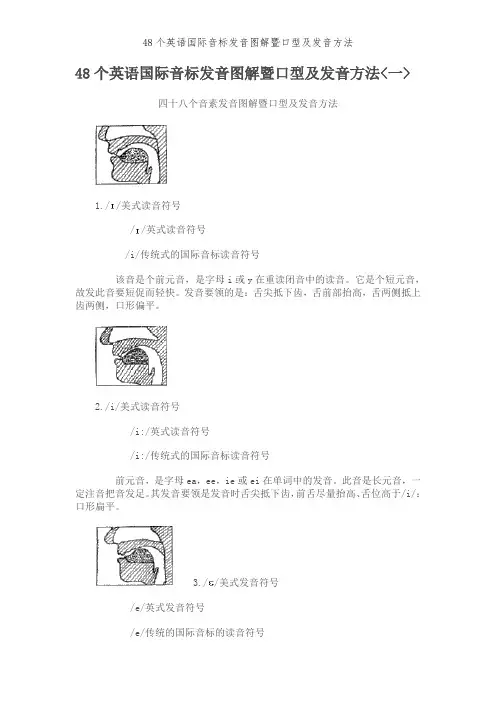
48个英语国际音标发音图解暨口型及发音方法<一>四十八个音素发音图解暨口型及发音方法1.//美式读音符号//英式读音符号/i/传统式的国际音标读音符号该音是个前元音,是字母i或y在重读闭音中的读音。
它是个短元音,故发此音要短促而轻快。
发音要领的是:舌尖抵下齿,舌前部抬高,舌两侧抵上齿两侧,口形偏平。
2./i/美式读音符号/i:/英式读音符号/i:/传统式的国际音标读音符号前元音,是字母ea,ee,ie或ei在单词中的发音。
此音是长元音,一定注音把音发足。
其发音要领是发音时舌尖抵下齿,前舌尽量抬高、舌位高于/i/:口形扁平。
3.//美式发音符号/e/英式发音符号/e/传统的国际音标的读音符号该音是个前元音,是字母e或ea在单词中的发音。
它是个短元音。
发音时舌尖抵下齿,舌前部稍抬起,舌位比/i:/低;唇形中常,开口度比/i:/大。
4.//美式读音符号//英式读音符号//传统的国际音标的读音符号该音是个前元素,是字母a在重读闭音节中的发音。
//是短元音。
发音时舌尖抵下齿;舌前部稍抬高,舌位比/e/更低;双唇平伸,成扁平形。
5.//美式读音符号//英式读音符号//传统的国际音标的读音符号该音是个后元音,是字母组合ar的读音,也是字母a在ss,st,th等字母前面的读音。
//是长元音。
发音时口张大,舌身压低并后缩,后舌稍隆起,舌尖不抵下齿。
双唇稍收圆。
6.//美式读音符号//英式读音符号//传统的国际音标的读音符号该音是个短元音,是字母o在重读闭音节单词中的读音。
发音时口张大,舌身尽量降低并后缩,双唇稍稍收圆。
7.//美式读音符号//英式读音符号//传统的国际音标的读音符号该音是个后元音,是字母o,or,al,oar,our或oor在单词中的发音。
它是长元音。
发音时舌后部抬得比//即美式//美式//高,双唇收得更圆更小,并向前突出。
8.//美式读音符号//英式读音符号/u/传统的国际音标的读音符号该音是个后元素,是英语字母u,oo或ou等在单词中的发音。
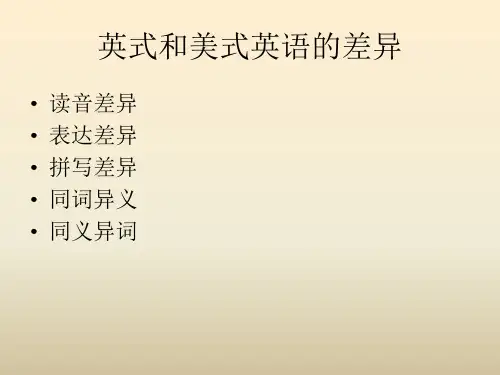
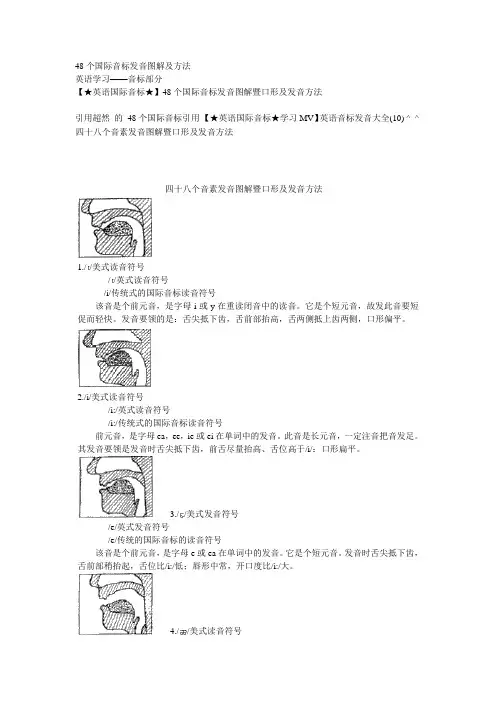
48个国际音标发音图解及方法英语学习——音标部分【★英语国际音标★】48个国际音标发音图解暨口形及发音方法引用超然的48个国际音标引用【★英语国际音标★学习MV】英语音标发音大全(10) ^_^ 四十八个音素发音图解暨口形及发音方法四十八个音素发音图解暨口形及发音方法1.//美式读音符号//英式读音符号/i/传统式的国际音标读音符号该音是个前元音,是字母i或y在重读闭音中的读音。
它是个短元音,故发此音要短促而轻快。
发音要领的是:舌尖抵下齿,舌前部抬高,舌两侧抵上齿两侧,口形偏平。
2./i/美式读音符号/i:/英式读音符号/i:/传统式的国际音标读音符号前元音,是字母ea,ee,ie或ei在单词中的发音。
此音是长元音,一定注音把音发足。
其发音要领是发音时舌尖抵下齿,前舌尽量抬高、舌位高于/i/:口形扁平。
3.//美式发音符号/e/英式发音符号/e/传统的国际音标的读音符号该音是个前元音,是字母e或ea在单词中的发音。
它是个短元音。
发音时舌尖抵下齿,舌前部稍抬起,舌位比/i:/低;唇形中常,开口度比/i:/大。
4.//美式读音符号//英式读音符号//传统的国际音标的读音符号该音是个前元素,是字母a在重读闭音节中的发音。
//是短元音。
发音时舌尖抵下齿;舌前部稍抬高,舌位比/e/更低;双唇平伸,成扁平形。
5.//美式读音符号//英式读音符号//传统的国际音标的读音符号该音是个后元音,是字母组合ar的读音,也是字母a在ss,st,th等字母前面的读音。
//是长元音。
发音时口张大,舌身压低并后缩,后舌稍隆起,舌尖不抵下齿。
双唇稍收圆。
6.//美式读音符号//英式读音符号//传统的国际音标的读音符号该音是个短元音,是字母o在重读闭音节单词中的读音。
发音时口张大,舌身尽量降低并后缩,双唇稍稍收圆。
7.//美式读音符号//英式读音符号//传统的国际音标的读音符号该音是个后元音,是字母o,or,al,oar,our或oor在单词中的发音。
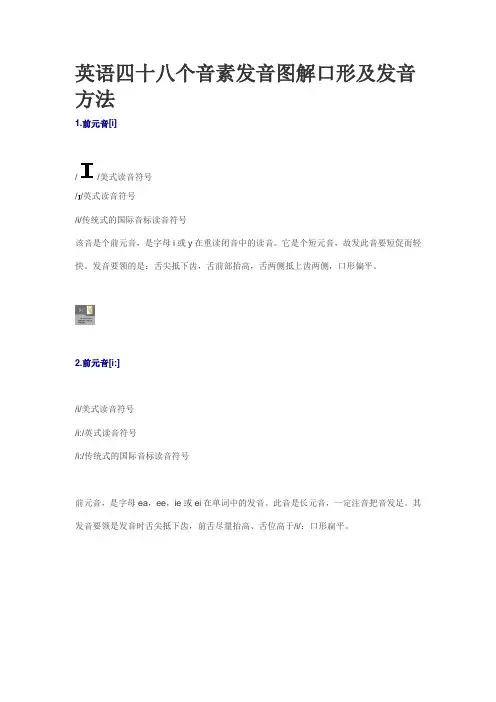
英语四十八个音素发音图解口形及发音方法1.前元音[i]//美式读音符号//英式读音符号/i/传统式的国际音标读音符号该音是个前元音,是字母i或y在重读闭音中的读音。
它是个短元音,故发此音要短促而轻快。
发音要领的是:舌尖抵下齿,舌前部抬高,舌两侧抵上齿两侧,口形偏平。
2.前元音[i:]/i/美式读音符号/i:/英式读音符号/i:/传统式的国际音标读音符号前元音,是字母ea,ee,ie或ei在单词中的发音。
此音是长元音,一定注音把音发足。
其发音要领是发音时舌尖抵下齿,前舌尽量抬高、舌位高于/i/:口形扁平。
3.前元音[e]//美式发音符号/e/英式发音符号/e/传统的国际音标的读音符号该音是个前元音,是字母e或ea在单词中的发音。
它是个短元音。
发音时舌尖抵下齿,舌前部稍抬起,舌位比/i:/低;唇形中常,开口度比/i:/大。
4.前元音[]//美式读音符号//英式读音符号//传统的国际音标的读音符号该音是个前元素,是字母a在重读闭音节中的发音。
//是短元音。
发音时舌尖抵下齿;舌前部稍抬高,舌位比/e/更低;双唇平伸,成扁平形。
5.后元音[]//美式读音符号//英式读音符号//传统的国际音标的读音符号该音是个后元音,是字母组合ar的读音,也是字母a在ss,st,th等字母前面的读音。
/ /是长元音。
发音时口张大,舌身压低并后缩,后舌稍隆起,舌尖不抵下齿。
双唇稍收圆6.短元音[]//美式读音符号//英式读音符号//传统的国际音标的读音符号该音是个短元音,是字母o在重读闭音节单词中的读音。
发音时口张大,舌身尽量降低并后缩,双唇稍稍收圆。
7.后元音[]//美式读音符号//英式读音符号//传统的国际音标的读音符号该音是个后元音,是字母o,or,al,oar,our或oor在单词中的发音。
它是长元音。
发音时舌后部抬得比//即美式//美式//高,双唇收得更圆更小,并向前突出。
8.后元音[u]//美式读音符号//英式读音符号/u/传统的国际音标的读音符号该音是个后元素,是英语字母u,oo或ou等在单词中的发音。
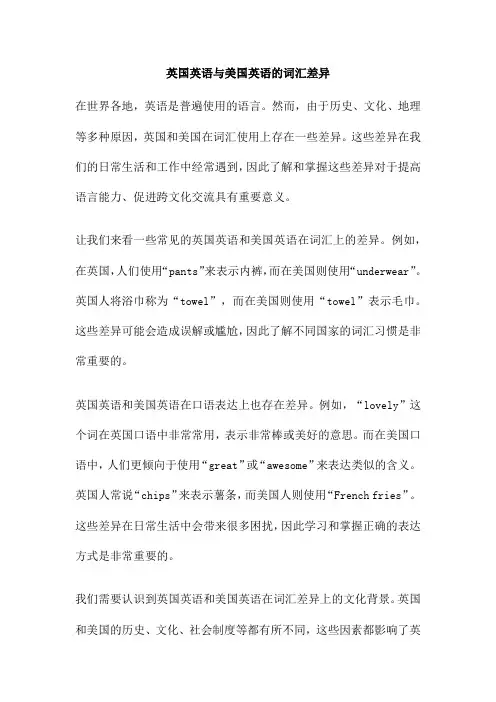
英国英语与美国英语的词汇差异在世界各地,英语是普遍使用的语言。
然而,由于历史、文化、地理等多种原因,英国和美国在词汇使用上存在一些差异。
这些差异在我们的日常生活和工作中经常遇到,因此了解和掌握这些差异对于提高语言能力、促进跨文化交流具有重要意义。
让我们来看一些常见的英国英语和美国英语在词汇上的差异。
例如,在英国,人们使用“pants”来表示内裤,而在美国则使用“underwear”。
英国人将浴巾称为“towel”,而在美国则使用“towel”表示毛巾。
这些差异可能会造成误解或尴尬,因此了解不同国家的词汇习惯是非常重要的。
英国英语和美国英语在口语表达上也存在差异。
例如,“lovely”这个词在英国口语中非常常用,表示非常棒或美好的意思。
而在美国口语中,人们更倾向于使用“great”或“awesome”来表达类似的含义。
英国人常说“chips”来表示薯条,而美国人则使用“French fries”。
这些差异在日常生活中会带来很多困扰,因此学习和掌握正确的表达方式是非常重要的。
我们需要认识到英国英语和美国英语在词汇差异上的文化背景。
英国和美国的历史、文化、社会制度等都有所不同,这些因素都影响了英语词汇的使用。
因此,在跨文化交流中,我们需要尊重和理解对方的文化习惯,避免因为语言差异而产生误解或冲突。
英国英语与美国英语的词汇差异是普遍存在的。
为了更好地促进跨文化交流和理解,我们需要不断学习和掌握正确的词汇和表达方式。
我们也需要尊重和理解对方的文化习惯,以实现更加顺畅和有效的沟通。
美国英语和英国英语,作为英语语言的两大主要变体,虽然有许多相似之处,但也有显著的差异。
这些差异主要体现在发音、用词、语法和习惯表达等方面。
本文将探讨造成这些差异的主要原因。
美国英语和英国英语在发音上的差异是最为明显的。
英国英语的发音通常较为柔和,语调变化不大,而美国英语的发音则较为强烈,语调变化较大。
例如,在英国英语中,单词“about”的发音类似于“a-bout”,而在美国英语中,则更接近于“a-boot”。
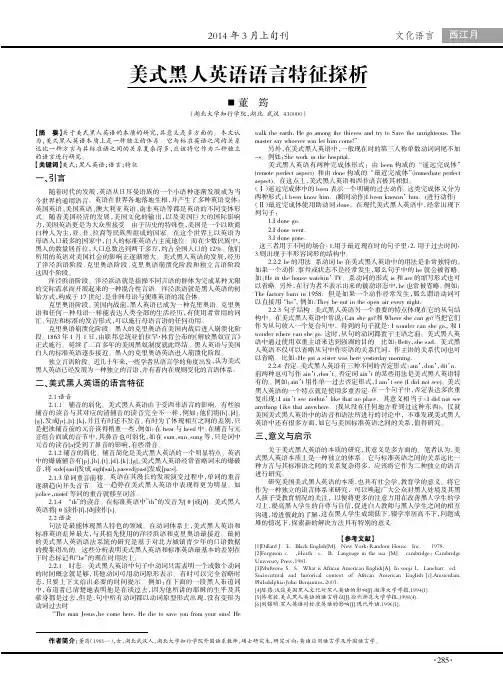
2014年3月上旬刊作者简介:董筠(1981—),女,湖北武汉人,湖北大学知行学院外国语系教师,硕士研究生,研究方向:英语应用语言学及外国语言学。
【摘要】关于美式黑人英语的本质的研究,其意义是多方面的。
本文认为,美式黑人英语本质上是一种独立的体系。
它与标准英语之间的关系远比一种方言与其标准语之间的关系复杂得多,应该将它作为二种独立的语言进行研究。
【关键词】美式;黑人英语;语言;特征一、引言随着时代的发展,英语从日耳曼语族的一个小语种逐渐发展成为当今世界的通用语言。
英语在世界各地落地生根,并产生了多种英语变体:英国英语、美国英语、澳大利亚英语、南非英语等都是英语的不同变体形式。
随着美国经济的发展,美国文化的输出,以及美国巨大的国际影响力,美国英语更是为大众所接受。
由于历史的特殊性,美国是一个以欧裔白种人为主,亚、非、拉裔等民族所组成的国家。
在这个世界上以英语为母语人口最多的国家中,白人的标准英语占主流地位。
而在少数民族中,黑人的数量居首位,人口总数达到两千多万,约占全国人口的12%。
他们所用的英语对美国社会的影响正逐渐增大。
美式黑人英语的发展,经历了洋泾浜语阶段、克里奥语阶段、克里奥语崩溃化阶段和独立言语阶段这四个阶段。
洋泾浜语阶段。
洋泾浜语就是指操不同言语的群体为完成某种无限的交际需求而开展起来的一种混合性言语。
洋泾浜语就是黑人英语的初始方式,构成于17世纪,是非洲母语与便准英语的混合体。
克里奥语阶段。
美国内战前,黑人英语已成为一种克里奥语。
克里奥语和任何一种母语一样能表达人类全部的生活经历,有使用者常用的词汇、句法和标准的发音形式,可以施行母语言语的任何功用。
克里奥语崩溃化阶段。
黑人的克里奥语在美国内战后进入崩溃化阶段。
1863年1月1日,由联邦总统亚伯拉罕·林肯公布的《解放黑奴宣言》正式施行。
延续了二百多年的美国黑奴制度就此终结。
黑人英语与美国白人的标准英语逐步接近。
黑人的克里奥语英语进入崩溃化阶段。

50个美式音标表读法1. /eɪ/:这个音标读作"ay",如在单词"day"中。
2. /ɑː/:这个音标读作"ah",如在单词"car"中。
3. /æ/:这个音标读作"ae",如在单词"cat"中。
4. /ɛ/:这个音标读作"eh",如在单词"bed"中。
5. /ə/:这个音标读作"uh",如在单词"about"中。
6. /ɪ/:这个音标读作"ih",如在单词"it"中。
7. /iː/:这个音标读作"ee",如在单词"see"中。
8. /ɔː/:这个音标读作"aw",如在单词"law"中。
9. /oʊ/:这个音标读作"oh",如在单词"go"中。
10. /ʊ/:这个音标读作"oo",如在单词"book"中。
11. /uː/:这个音标读作"oo",如在单词"moon"中。
12. /aɪ/:这个音标读作"ai",如在单词"like"中。
13. /aʊ/:这个音标读作"ow",如在单词"house"中。
14. /ɔɪ/:这个音标读作"oy",如在单词"boy"中。
15. /p/:这个音标读作"p",如在单词"pen"中。
16. /b/:这个音标读作"b",如在单词"bed"中。
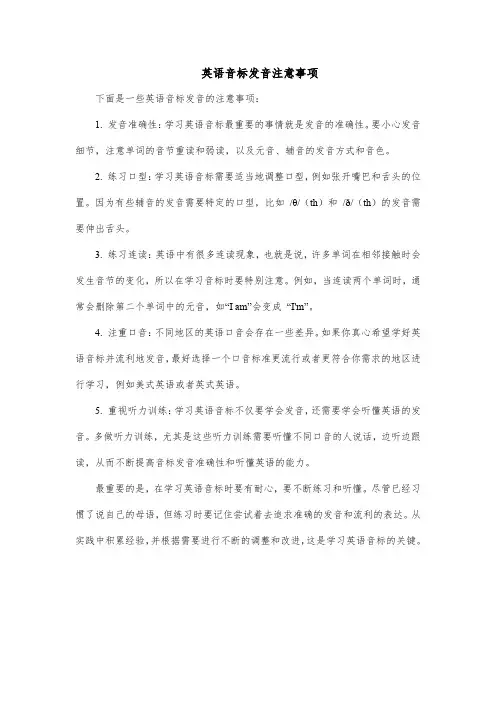
英语音标发音注意事项
下面是一些英语音标发音的注意事项:
1. 发音准确性:学习英语音标最重要的事情就是发音的准确性。
要小心发音细节,注意单词的音节重读和弱读,以及元音、辅音的发音方式和音色。
2. 练习口型:学习英语音标需要适当地调整口型,例如张开嘴巴和舌头的位置。
因为有些辅音的发音需要特定的口型,比如/θ/(th)和/ð/(th)的发音需要伸出舌头。
3. 练习连读:英语中有很多连读现象,也就是说,许多单词在相邻接触时会发生音节的变化,所以在学习音标时要特别注意。
例如,当连读两个单词时,通常会删除第二个单词中的元音,如“I am”会变成“I'm”。
4. 注重口音:不同地区的英语口音会存在一些差异。
如果你真心希望学好英语音标并流利地发音,最好选择一个口音标准更流行或者更符合你需求的地区进行学习,例如美式英语或者英式英语。
5. 重视听力训练:学习英语音标不仅要学会发音,还需要学会听懂英语的发音。
多做听力训练,尤其是这些听力训练需要听懂不同口音的人说话,边听边跟读,从而不断提高音标发音准确性和听懂英语的能力。
最重要的是,在学习英语音标时要有耐心,要不断练习和听懂。
尽管已经习惯了说自己的母语,但练习时要记住尝试着去追求准确的发音和流利的表达。
从实践中积累经验,并根据需要进行不断的调整和改进,这是学习英语音标的关键。
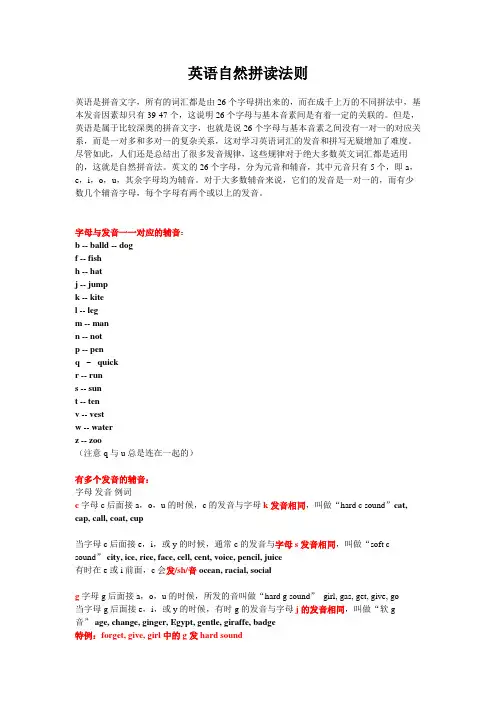
英语自然拼读法则英语是拼音文字,所有的词汇都是由26个字母拼出来的,而在成千上万的不同拼法中,基本发音因素却只有39-47个,这说明26个字母与基本音素间是有着一定的关联的。
但是,英语是属于比较深奥的拼音文字,也就是说26个字母与基本音素之间没有一对一的对应关系,而是一对多和多对一的复杂关系,这对学习英语词汇的发音和拼写无疑增加了难度。
尽管如此,人们还是总结出了很多发音规律,这些规律对于绝大多数英文词汇都是适用的,这就是自然拼音法。
英文的26个字母,分为元音和辅音,其中元音只有5个,即a,e,i,o,u,其余字母均为辅音。
对于大多数辅音来说,它们的发音是一对一的,而有少数几个辅音字母,每个字母有两个或以上的发音。
字母与发音一一对应的辅音:b -- balld -- dogf -- fishh -- hatj -- jumpk -- kitel -- legm -- mann -- notp -- penq –quickr -- runs -- sunt -- tenv -- vestw -- waterz -- zoo(注意q与u总是连在一起的)有多个发音的辅音:字母发音例词c字母c后面接a,o,u的时候,c的发音与字母k发音相同,叫做“hard c sound”cat, cap, call, coat, cup当字母c后面接e,i,或y的时候,通常c的发音与字母s发音相同,叫做“soft c sound”city, ice, rice, face, cell, cent, voice, pencil, juice有时在e或i前面,c会发/sh/音ocean, racial, socialg字母g后面接a,o,u的时候,所发的音叫做“hard g sound”girl, gas, get, give, go当字母g后面接e,i,或y的时候,有时g的发音与字母j的发音相同,叫做“软g音”age, change, ginger, Egypt, gentle, giraffe, badge特例:forget, give, girl中的g发hard soundx x在单词中间或结尾时发/ks/音box, next, mix, six, foxx在单词中间时有时发/gz/音exit, exam, exactx在单词起始位置时发/z/音xylophone, xeroxy y在单词起始位置时发音为辅音yes, you, yard, year, yelly在单词或音节中间或结尾时被当做元音y在结尾,单词只有一个音节时y发长/i/音,y在结尾,单词有两个或以上音节时y发长/e/音y在单词或音节中间时,发短/i/音小测试:my, cry, fly, sky自然拼音法系列之二——辅音字母组合辅音字母组合的发音很简单,就是把每个辅音字母的发音连在一起就可以了。
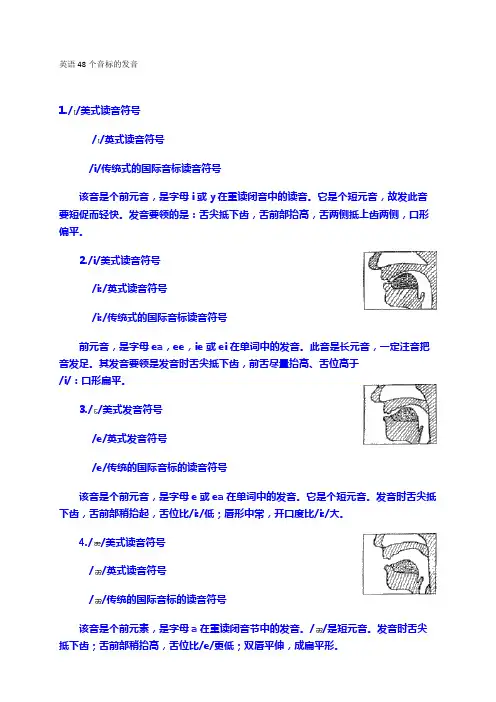
英语48个音标的发音1.//美式读音符号//英式读音符号/i/传统式的国际音标读音符号该音是个前元音,是字母i或y在重读闭音中的读音。
它是个短元音,故发此音要短促而轻快。
发音要领的是:舌尖抵下齿,舌前部抬高,舌两侧抵上齿两侧,口形偏平。
2./i/美式读音符号/i:/英式读音符号/i:/传统式的国际音标读音符号前元音,是字母ea,ee,ie或ei在单词中的发音。
此音是长元音,一定注音把音发足。
其发音要领是发音时舌尖抵下齿,前舌尽量抬高、舌位高于/i/:口形扁平。
3.//美式发音符号/e/英式发音符号/e/传统的国际音标的读音符号该音是个前元音,是字母e或ea在单词中的发音。
它是个短元音。
发音时舌尖抵下齿,舌前部稍抬起,舌位比/i:/低;唇形中常,开口度比/i:/大。
4.//美式读音符号//英式读音符号//传统的国际音标的读音符号该音是个前元素,是字母a在重读闭音节中的发音。
//是短元音。
发音时舌尖抵下齿;舌前部稍抬高,舌位比/e/更低;双唇平伸,成扁平形。
5.//美式读音符号//英式读音符号//传统的国际音标的读音符号该音是个后元音,是字母组合ar的读音,也是字母a在ss,st,th等字母前面的读音。
//是长元音。
发音时口张大,舌身压低并后缩,后舌稍隆起,舌尖不抵下齿。
双唇稍收圆。
6.//美式读音符号//英式读音符号//传统的国际音标的读音符号该音是个短元音,是字母o在重读闭音节单词中的读音。
发音时口张大,舌身尽量降低并后缩,双唇稍稍收圆。
7.//美式读音符号//英式读音符号//传统的国际音标的读音符号该音是个后元音,是字母o,or,al,oar,our或oor在单词中的发音。
它是长元音。
发音时舌后部抬得比//即美式//美式//高,双唇收得更圆更小,并向前突出。
8.//美式读音符号//英式读音符号/u/传统的国际音标的读音符号该音是个后元素,是英语字母u,oo或ou等在单词中的发音。
/u/是短元音。
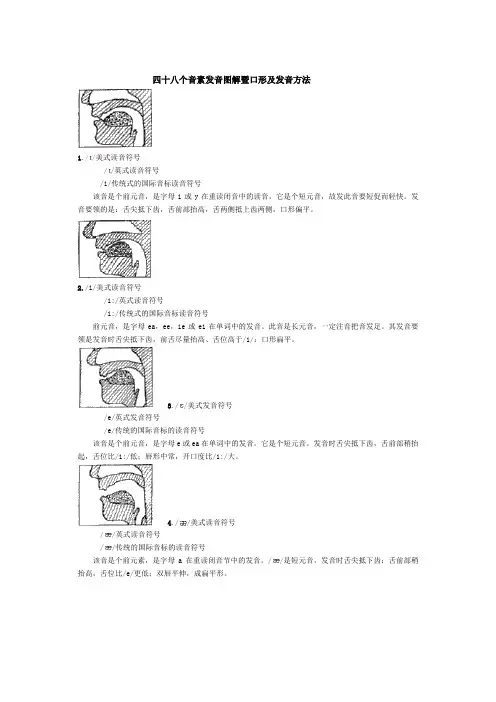
四十八个音素发音图解暨口形及发音方法1.//美式读音符号//英式读音符号/i/传统式的国际音标读音符号该音是个前元音,是字母i或y在重读闭音中的读音。
它是个短元音,故发此音要短促而轻快。
发音要领的是:舌尖抵下齿,舌前部抬高,舌两侧抵上齿两侧,口形偏平。
2./i/美式读音符号/i:/英式读音符号/i:/传统式的国际音标读音符号前元音,是字母ea,ee,ie或ei在单词中的发音。
此音是长元音,一定注音把音发足。
其发音要领是发音时舌尖抵下齿,前舌尽量抬高、舌位高于/i/:口形扁平。
3.//美式发音符号/e/英式发音符号/e/传统的国际音标的读音符号该音是个前元音,是字母e或ea在单词中的发音。
它是个短元音。
发音时舌尖抵下齿,舌前部稍抬起,舌位比/i:/低;唇形中常,开口度比/i:/大。
4.//美式读音符号//英式读音符号//传统的国际音标的读音符号该音是个前元素,是字母a在重读闭音节中的发音。
//是短元音。
发音时舌尖抵下齿;舌前部稍抬高,舌位比/e/更低;双唇平伸,成扁平形。
5.//美式读音符号//英式读音符号//传统的国际音标的读音符号该音是个后元音,是字母组合ar的读音,也是字母a在ss,st,th等字母前面的读音。
//是长元音。
发音时口张大,舌身压低并后缩,后舌稍隆起,舌尖不抵下齿。
双唇稍收圆。
6.//美式读音符号//英式读音符号//传统的国际音标的读音符号该音是个短元音,是字母o在重读闭音节单词中的读音。
发音时口张大,舌身尽量降低并后缩,双唇稍稍收圆。
7.//美式读音符号//英式读音符号//传统的国际音标的读音符号该音是个后元音,是字母o,or,al,oar,our或oor在单词中的发音。
它是长元音。
发音时舌后部抬得比//即美式//美式//高,双唇收得更圆更小,并向前突出。
8.//美式读音符号//英式读音符号/u/传统的国际音标的读音符号该音是个后元素,是英语字母u,oo或ou等在单词中的发音。
美式音标表辅音爆破音p b t d k ɡ摩擦音 f v s ʃθ zʒðh塞擦音ʧʤ鼻音m n ŋ流音 1 r滑音w j元音前元音i ɪ e ɛæ a中元音ʌəɝɚ后元音u ʊo ɔɑ双元音ɑɪɑʊɔɪˈˈʼʹˊ附:后元音及双元音里的ɑ在有些资料里常写作ɑ,这里为了和以上的字体保持一致,用ɑ代表。
1、美式英语有明显的“r”音,英式英语则没有。
如:工人worker一词,美式英语读法为|'w∂:rk∂|,英式英语为|'w∂:k∂|2、英式英语中读|a:|,在美式英语中读|æ|。
如pass一词,美式英语读|pa:s|,美式英语读|pæs|,类似的词有ask等。
3、英式英语中读|O|的音,美式英语读|a:|如box一词,英式读| bOks |,英式读|ba:ks|,类似的还有watch等4、英式英语习惯将单词略读,美式英语则习惯把每个音节全部读出。
例如:interesting一词英式读法为|'intristiŋ|,美式读法则为|'int∂ristiŋ|5、英式英语读| i |音,美式英语读| ∂ |,如:system一词,英式为|'sistim|,美式为|'sist∂m|6、有一些词英式英语和美式英语发音完全不同。
例如:leisure英式为|'leз∂|美式为|'li:z∂r|48个国际音标表[i:] [E:] [E] [O:] [O] [u:] [A:] [V] [Q] [e] [ai] [ei] [Oi] [iE] [CE] [uE] [Eu] [au] [p] [t] [d] [k] [g] [f] [v] [s] [z] [T] [D] [S][Z] [tS] [dZ] [tr] [dr] [ts] [dz] [m] [n] [N] [h] [r] [l] [w] [j]英语国际音标共48个,其中20个元音,20个辅音,3个鼻音,2个半元音,3个似拼音元音12个单元音长元音[i:] [E:] [O:] [u:] [A:]短元音[E] [O] [V] [Q] [e]8个双元音: [ai] [ei] [Oi] [iE] [CE] [uE] [Eu] [au]辅音10对清辅音[p] [t] [k] [f] [s] [T] [S] [tS] [tr] [ts]浊辅音[d] [g] [v] [z] [D] [Z] [dZ] [dr] [dz]3个鼻音[m] [n] [N]3个似拼音[h] [r] [l]2个半元音[w] [j]巧记48个国际音标单元音共十二,四二六前中后。
美式英语中的连读现象1.击穿连读——人间蒸发的h、t、th击穿不同于失去爆破,被击穿的音素的前后两个音素可以直接连读,构成理想音节。
击穿现象一:him、her、his等的首字母“h”可被击穿;代词击穿现象二:非重读音节中,当t或d在n的后面,读快了就会被击穿,n直接和后面的元音拼起来。
击穿现象三:在语速较快时,them中的th可以被击穿,从而读作'em。
2.元音连读当前一个单词以元音结尾而紧接着的单词又以元音开头时,两个元音应尽量连起来念, 必要时两个单词中间可以加个轻柔的/j/或/w/作为转折,如my arm;又如"too expensive",说too的时候嘴唇是撅起来的,在说expensive的时候嘴形来不及恢复,所以就带出一个比较弱的/w/的音,这种现象为元音连读1.失去爆破的情况:当前面一个词以爆破音/b,p,t,d,k,g/结尾,第二个单词也以爆破音开头,或其第二个音是字母ch,j,m,n,th的发音时,第一个爆破音失去爆破;另外,/t,d/在/l,s/前面也失去爆破2.连读情况:第一个单词以辅音结尾,第二个单词以元音(不是5个元音字母,而是20个元音音素)开头,自然形成连读情况如:look at;a lot of,...如果一个单词以r结尾,第二个单词以元音开头,原来不单独发音的r增加发音/ r /。
3.经验:当前面一个词以爆破音/b,p,t,d,k,g/结尾,第二个单词以/ h /开头,由于气流受阻的缘故,/ h /的读音会被掩盖,因而听起来好像/ h /失去了读音,如:let him,meet her,....4.音的同化:第一个单词结尾的音受到第二个单词开头音的影响发生改变,如:does she中/ z /的发音如同treasure中s的发音,I should think so.中的/ d /发/ t /的音。
地道美式英语发音规则及总结1. 击穿连读(1)/h/很弱,很容易被击穿with+him=with(h)imwith+her=with(h)er(2)/t/和/d/在/n/后通常被击穿twenty--twen(t)yinternet--in(t)ernetwanted--wan(t)edand+I=an(d) I(3)/th/在/n/后有时也被击穿seen+that=seen (th)atI've never seen that movie.(4)with后如果有弱读的元音音节,with有时会变成/wit/with+our=wit(h)arwith+it=wit(h)Di2. 失去爆破爆破音(t d k g p b)后接除了/j/, /w/, /r/之外的辅音要失去爆破*遇到/h/可算到击穿连读的情况里3. 融合t+j=chNice to meet you.d+j=d3I called you yesterday.s+j=shGod bless you.z+j=3I'll do as you wish.4. 闷音garden, student, sentence5.浊化(1)t的浊化Italy, later, betterItalian, hotel(2)s后爆破轻辅音的浊化sky, star, speak一、连读的条件:相邻的两词在意义上必须密切相关,同属一个意群。
连读所构成的音节一般都不重读,只需顺其自然地一带而过,不可读得太重,也不可音。
(连读符号:~)二、连读规则1.“辅音+元音”型连读在同一个意群里,如果相邻两词中的前一个词是以辅音结尾,后一个词是以元音开头,这就要将辅音与元音拼起来连读。
I’m~an~English boy.It~is~an~old book.Let me have~a look~at~it.Ms Black worked in~an~office last~yesterday.I called~you half~an~hour~ago.Put~it~on, please.Not~at~all.Please pick~it~up.2.“r/re+元音”型连读如果前一个词是以-r或者-re结尾,后一个词是以元音开头,这时的r或re不但要发/r/,而且还要与后面的元音拼起来连读。
英语音标特殊发音规则英语音标特别发音规章英语中同一个字母有许多不同的发音规章,英语音标有哪些特别发音规章呢?下面我就和大家共享英语音标特别发音规章,盼望能够关心到大家,来观赏一下吧。
英语音标特别发音规章1. 元音字母在重读音节中的读音a:在开音节中/eɪ/如:name plane Jane baby cake make take在闭音节中/æ/如:bag dad hat map black backee: 在开音节中/i:/如:he these me Chinese bee green tree在闭音节中/e/如:bed let pen desk yesi(y)i:在开音节中/aɪ/如:bike fly drive time nice kite在闭音节中/ɪ/如:fish big drink sit milk swim pig sixoo:在开音节中/əʊ/如:those close go hoe home no在闭音节中/ɒ/,美式英语中常常发/ɑ/如:clock not box shop sock doll orange doguu:在开音节中/ju:/如:student excuse duty Tuesday在闭音节中/ʌ/如:bus cup jump much lunch duck在开音节中,元音字母u在辅音字母j,l,r,s后面时读/u:/音,例如:June blue ruler super2. 元音字母在非重读音节中的读音/ə/ China another breakfast pedal/ɪ/ orange comrade village cabbagee/ə/hundred student open children/ɪ/ chicken pocket begin/ə/或/ɪ/ holiday beautiful family animal/aɪ/ exercise satelliteo/ə/ second tonight somebody welcome control/əʊ/ also zero photou/ə/ autumn difficult/ju:/ popular congratulation January3. 元音字母在重读音节中的特别读音a在/w/音后面/ɒ/ want what watch wash qualitya在f,n,sk,ph,sp,ss,st,th前/ɑ:/after plant graph ask grasp glass fast fatheri在-nd,-ld和-gh前/aɪ/ find child light higho在-st,-ld前/əʊ/ most postcard old coldo在m,n,v,th前u /ʌ/ come monkey love mother音标发音技巧英语国际音标及语音的基本常识一、音素1、单元音:2、双元音:3、清、浊辅音:二、语音的基本常识1、音节的划分一个单词的音标中有几个元音就有几个音节。
a在开音节中[ei] name plane Jane baby cake在闭音节中[æ] bag dad hat map black backe 在开音节中[i:] he these me Chinese在闭音节中[e] bed let pen desk yes eggi 在开音节中[ai] bike fly drive time nice kite在闭音节中fish big drink sit milk swimo 在开音节中[ou] those close go hoe home no在闭音节中[C] clock not box shop socku 在开音节中[ju:] student excuse duty Tuesday在闭音节中[∧] bus cup jump much lunch在开音节中,元音字母u在辅音字母j l r s后面时读[u:]音,例如:June blue ruler super二、元音字母在重读音节中的特殊读音元音字母读音例词a在[w]音后面[C] want what watch wash qualitya在f n sk ph sp ss st th前[α:] after plant graph ask grasp glass fast fatheri在-nd -ld和gh前[ai] find child light higho在-st -ld前[ou] most postcard old coldo在m n v th前[∧] come monkey love mother三、元音字母在非重读音节中的读音元音字母读音例词a [E]E China another woman breakfastorange comrade village cabbagee [E] hundred student open weekendchicken pocket begin childreni [E]/ holiday beautiful family animal[ai] exercise satelliteo [E] second tonight somebody welcome[Eu] also zero photou [E] autumn difficult[ju:] popular congratulation January动词中的a如果处在开音节位置,a读[ei]音,例如:operateu处在开音节位置,又在辅音字母j l r s后面时,读[u(:)]音,例如:July influence February issue在非重读音节中,许多单词中的元音字母a e i 即可以读作[E]音,也可以读作音。
语音、音素、音标及美式和英式英标的区别语言:语言是人类特有的用来表达意思、交流思想的工具。
语言由语音、词汇和语法三部分组成。
语言形式有两种,一种是用口头表达的,称为口语;一种是用书面表达的,称为书面语。
语音:语音是语言用声音表达的形式,就是人说话的声音。
音素:人说话的声音是由若干单个的音组成的,即使是一个很短的字、词也是由一定的读音组成的。
英语把组成一个读音的最小单位叫音素。
音标:人说话的声音没有形状,怎样把说话的声音记载下来人们发明了音标,即给每个音都设一个符号,让固定的符号去代表某个字母、单词的读音。
这个符号或这些符号就叫音标。
音标是记载语音的符号。
我们这里所说的英语音标就是记载英语字母和单词的读音的符号。
我们现在所说的音标已不仅仅指传统的国际音标。
从印刷和书写形式上看还有其它两种,一种是标示美式英语发音的,我们称之为美式英语音标;另一种是标示英式英语发音的,我们称之为英式英语音标。
国际音标,美式音标,英式音标的书写和印刷形式已有了较大区别,尤其体现在元音音素的书写和印刷上。
这是美式英语不停地从英式英语悄然脱变的必然结果。
学习者必须注意三种音标形式的区别。
英语用来给字母和单词注音的符号,共48个。
每个符号是一个音素。
单个音素一般不能给字母和单词注音,因此单个音素一般不能被称作音标。
能称作音标的是几个音素拼读在一起的形式。
音素成为音标必须用括号[ ]括起来,或用两条斜线/ /标出来。
括号[ ]和斜线/ /被称作音标符号。
/ /是近些年为书写时快捷和微机操作时方便而发明的新的音标符号。
英语用来组拼音标的48个符号或48个音素课见下面的英语音素一览表(Pronunciation Table)元音音素(Vowels)美式音素符号英式音素符号传统式国际音标的音素符号i i:i:ie eueiaiiiu辅音音素(Consonants)美式音素符号英式音素符号传统式国际音标的音素符号p p pb b bt t td d dk k kgf f fv v vs s sz z z∫∫∫h h hm m mn n nw w wl l lr r ry j jtrdrtsdz依据发音的特点,我们把前左表的音素称作元音音素,把右表的音素称为辅音音素。
Session Three1. The Unvoiced TH Sound2. The Voiced TH Sound3. THR Blends4. Voicing the T SoundHi, welcome back. Again my name is Paul Gruber and this is the Pronunciation Workshops---Third Training Session. In this class, we will cover the American TH sounds, both the unvoiced TH[θ] and the voiced TH[ð]. This is one of my favorite areas because when you correctly produce TH sounds, you will significantly improve the way you speak English. Later on in this video, we’ll also address voiced T sounds.Now except for maybe a few languages, English is one of the only languages in the world that has TH sound when your tongue comes out between your teeth[θ] that you may have a difficult time with this sound because this sound probably does not exist in your own native language. Therefore, you don’t think to use the sound when you speak English. Most likely, you just substitute another sound, like a T or an S. So instead of saying a word like Thumb, my Thumb, which this is and notice my tongue is coming out. My thumb. You’ve been saying Tumb. My Tumb or my Sumb and your tongue is not coming out. That is not correct. If you made mistake like this and connected speech over and over again. There’s a good chance people are not going to understand you. I have found that some people from different cultures of the world find the idea of sticking out their tongue when they speak to be rude and offensive even if it is to produce a TH sound, I want you to understand that this is how American speak English and it is something that you must become comfortable with if you wish to speak well. To produce TH sound correctly you need to first stick your tongue out between your teeth and bite down slightly[θ],then blow[θ].This created Air Friction. The sound comes from the air friction and should be pretty lou d[θ]. Keep your tongue flat and maintain it even steady flow of air. I’ m not just saying stick it out a little bit, I’ m saying stick it way out at least while you’re practising to get used to the feeling. The TH sound comes from the air and the friction. You have got to hear it and should be somewhat loud [θ], like that. If you’re like most people, you may need to work on this a little bit but trust me I know you can do it. Hundreds of my clients who have never produced a TH sound in their lives are speaking English clearly and beautifully, because they’ve learned how to do this. It may help if you look at a mirror and watch your mouth and tongue. See if you can maintain the air flow for three seconds [θ], like that. I know this may feel very strange and uncomfortabl e to do possibly, but soon you’ll get used to it and the small change in your speech is going to really improve how your English sounds. Now the TH sound is a friction sound and it’s not as aloud as other speech sounds. Therefore American speakers stretch them out a little bit we don’t even realize we do this, but this make the sound come out clearer. Let me show you what I mean. Let’s look again at the word Thumb. For practicing purposes, think of the word in two beats: One. Two. [θ]Thumb. You s e e that? Notice how long I’m holding the TH sound. [θ]Thumb. It’s not good enough just to put your tongue between your teeth and say a TH word. Like this~. You see that, my tongue came out. But there was never any air friction. That’s not good. You must s tretch out the TH sound and hear the air friction. Thumb. Like that. Let’s pra ctise some words with TH sounds. First at the beginning of words. Here we go.ThanksThickThunderThursdayThinkNow in the middle of words.AnythingBathmatToothpickAthleticMouthwashNow at ends of words.BathNorthBeneathFourthSouthVery good. Ok now let’s talk about voiced TH sounds. To make a voiced TH sound, all you have to do is take the TH sound that I just showed you and just add voicing [ð]. There’s the voiced TH. You should be able to feel the strong vibration in your throat and on your tongue [ð].Let’s go over some of these voiced TH sounds. This first set of words are some of those the most commonly used words in English and yes they should all be voiced and all made with your tongue coming through your teeth. First at the beginning of words.The (The book)That (That house)They (They came over)Them (Give them water)There (There it is)This (This is my nose)Those (Those boys are good)These (These are my parents)You know, another good way to practise these words is by goingaround your room and naming everything you see using a TH word. For example, the chair, that window, those books, this door, like that. Then go around and name your body parts in some clothing like that shoe, this watch, these feet. Ok. That may be helpful. Let’s look at these voiced TH sounds in the middle of words.Clothing. Notice how my tongue comes out in the middle of the word and the TH sound is pushed out. Clothing.Leather. Same thing. Stick out your tongue and make a very strong vibration. Leather.MotherAnotherWeatherNorthernAnd now at the ends of words.Smooth. Believe it or not. The TH in Smooth is voiced. Most foreign speakers say this word incorrectly. They say Smooth, the unvoiced TH. But it’s voiced. Smooth [ð].Bathe. The word Bath is a noun, with an unvoiced TH. Bath. But when you change it into a verb “to bathe” the vowel changes to an /e/ sound and the TH is voiced. Bathe, like again. Batheing suit.Breathe. Same thing. Breath is a noun. Take a breath, unvoiced. But when you change it into a verb, the vowel changes and becomes Breathe. I am breathing with the voiced TH. Now, let’s do some practice phrases. These all have voiced and unvoiced TH sounds. Repeat after me.This and thatA tableclothWinter clothingAthens, GreeceThat’s the oneHer skin is smoothThirty Day’s noticeA famous authorHere and thereFalse teethThread the needleA thoughtful giftThunder and lighteningThumbs upRepeat these sentences.Thelma arrived in town last Thursday.I’m having trouble threading this needle.I need 33 thick thermometers.The thing they like best about Athens is the weather.This thrilling novel was written by a famous author.He will be through with his work at three-thirty.Now and then, she likes to buy new clothing.They thought they were going to Northern Spain.Which tablecloth shall we use for the party?That was the thirty-third theatre to open.Now, I’d like to talk about THR Blends which is the combinat ion of TH sound and the R sound. Like in the word Thrill or Throw. When producing these blends, I want to be aware that the R is the strongest sound of the blend and it’s louder than the TH. Just like what we talked about in the first session. So when you say a word which begins with THR. First make the TH sound and then strongly push out the R. Let’s practise afew of these.Thread (thread the needle)Throw (throw the ball)Throat (my throat is sore)Thrill (a thrilling ride)Three (three more days)Threw (yesterday he threw the ball)Throne (the king sits on a throne)Ok, now let’s go over this reading paragraph. It has many TH sounds and it might be difficult, but it is a very good paragraph to practise on. You may wanna watch me do this a number of times. Keep your eyes on my mouth and notice how often my tongue comes out. Try to do the same thing. Here we go.Nurse Thatcher was thankful it was Thursday. She knew that on Thursday she had to deliver 33 boxes of thermometers to the North American Athletic Club. They thought that thermometers were necessary for testing the hydrotherapy baths. This was thought to benefit the athletes with arthritis. The athletic trainers required authorization to provide hydrotherapy to the youthful athletes on the three bulletin boards with thumbtacks through out the athletic club. Rather than risk the health of the athletes, they thoroughly checked the thousands of thermometers to insure their worthiness; otherwise they needed to be thrown away.Very good, I h ope that wasn’t too bad. As I said that is an excellent paragraph to practise on. You should review it a few times if you can.Ok, now as I always said English is a crazy language and there are always to be exceptions. Here are a few TH exceptions that I’d like to point out. Although these next words and names are spelled with TH. They’re pronounced as if they were spelled with a normal T/t/, like that. And thesewords are:ThomasThompsonTheresaThailandThames, like the riverEstherThyme, which is a spiceOk, now let’s take a moment and talk about T sounds. The T sound is the unvoiced sound like in the name Tom or the word TV. If you add voicing to a T, what do you get? /t/---/d/, a D. Remember? We went over this in the first session, but I want to tell you is in American pronunciation we like to make things easy. So if a letter T falls between two vowel sounds, which are voiced. So if it falls in the middle of vowels, then the T is pronounced as a D and the whole word is voiced. This is very easy and you may already be doing this correctly. Here are three examples:Water is pronounced as Wader, the T into a D and the whole word is voiced. Water . I want water.Better becomes Bedder. She’s feeling better.And Butter becomes Budder. Please pass the butter.This should be simple. So now that you know that. Practising this poem with me. Remember all the Ts are pronounced as Ds because they fall between vowels.Betty bought a bit of better butter. But, said she, this butter’s bitter. If I put it in my batter, it’ll make m y batter bitter.Again, notice that you do not hear any T sounds /t/. They are only Ds /d/, which are voiced. Go over this poem a few times. It’s also printed in your manual. Once you get good at it, try to speed it up. I’ll do it one moretime for you a little bit faster:Betty bought a bit of better butter. But, said she, this butter’s bitter. If I put it in my batter, it’ll make my batter bitter.Well, that was mouthful. Ok, start by practising it slow and then later get faster. Try to let the wo rds just roll out of your mouth. That’s for today’s session. Try spending some time in front of a mirror and practising these TH sounds like Thumb and Throw. The small change will really improve your English and make yo u a lot more understandable. I’m Paul Gruber with the Pronunciation Workshop and I’ll see you at our next session. Good bye!。